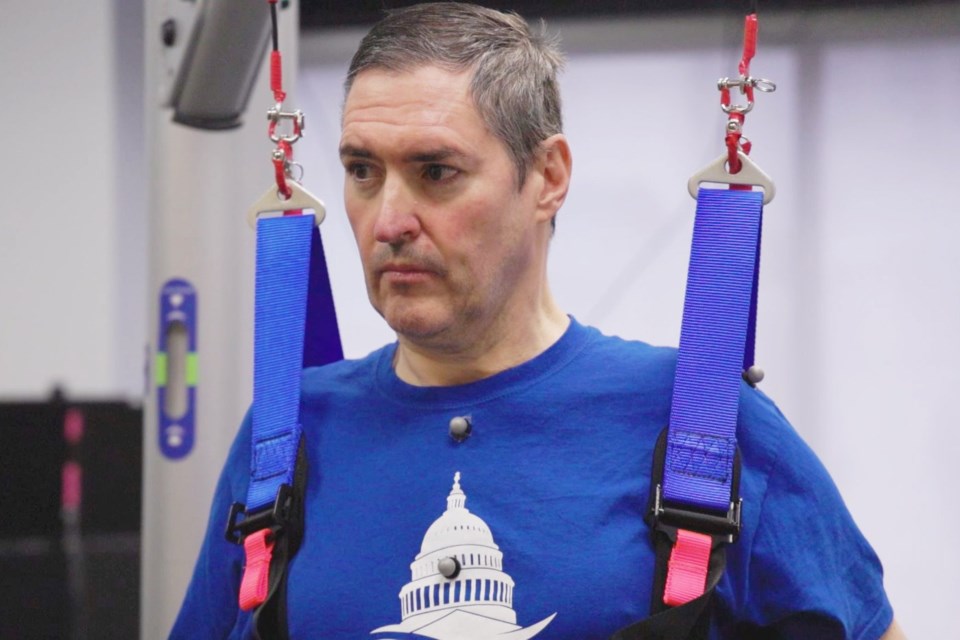WASHINGTON (AP) — Three people with a muscle-destroying disease destined to worsen got a little stronger – able to stand and walk more easily – when an implanted device zapped their spinal cord.
On Wednesday, researchers reported what they called the first evidence that a spine-stimulating implant might also aid neurodegenerative diseases like spinal muscle atrophy – by restoring some muscle function, at least temporarily.
“These people were definitely not expecting an improvement,” said Marco Capogrosso, an assistant professor at the University of Pittsburgh who led the research. Yet over the month-long pilot study, “they were getting better and better.”
Spinal muscle atrophy or SMA is a genetic disease that gradually destroys motor neurons, nerve cells in the spinal cord that control muscles. That leads muscles to waste away, especially in the legs, hips and shoulders and sometimes those involved with breathing and swallowing. There is no cure. A gene therapy can save the lives of very young children with a severe form of the disease, and there are some medicines to slow worsening in older patients.
Stimulating the spinal cord with low levels of electricity has long been used to treat chronic pain but Capogrosso’s team also has tested it to help people paralyzed from strokes or . While turned on, it zaps circuits of dormant nerves downstream of the injury to activate muscles.
Then Capogrosso wondered if that same technology might help SMA in a similar way — by revving up related sensory nerves so they wake up damaged muscle cells, helping them move to combat wasting.
The Pitt researchers implanted electrodes over the lower spinal cord of three adults with SMA and tested their muscle strength, fatigue, range of motion and changes in gait and walking distance when the device was firing and when it was turned off.
It didn’t restore normal movement but with just a few hours of spinal stimulation a week, all quickly saw improvements in muscle strength and function, researchers reported in the journal Nature Medicine.
“With a progressive disease you never get any better,” said study participant Doug McCullough, 57, of Franklin Park, New Jersey. “Either you’re staying stable or getting worse. So having any improvement is just a really surreal and very exciting benefit.”
All three participants significantly increased how far they could walk in six minutes, and one who initially couldn’t stand from a kneeling position could by the study’s end, Capogrosso said. And McCullough’s gait changed so that each step was about three times longer.
“They get less fatigued so they can walk for longer,” Capogrosso said. “Even a person this many years into the disease can improve.”
Intriguingly, researchers found the improvements didn’t disappear as soon as the stimulator was switched off, though they did fade as participants were tracked after the study ended.
McCullough said even when the stimulator was turned off, some nights his legs “would just feel supercharged.”
While he understood that the device had to be removed at the study’s end, he was disappointed. He said there were some lingering benefits at his six-week checkup, but none after six months.
Neuroscientist Susan Harkema, who led pioneering studies of stimulation for spinal cord injuries while at the University of Louisville, cautioned the new study is small and short but called it an important proof of concept. She said it’s logical to test the technique against a list of muscle-degenerating diseases.
“Human spinal circuitry is very sophisticated – it’s not just a bunch of reflexes controlled by the brain,” said Harkema, now with the Kessler Foundation, a rehabilitation research nonprofit. “This is a very solid study, an important contribution to move forward.”
At Pitt, Capogrosso said some small but longer studies are getting underway.
___
The Associated Press Health and Science Department receives support from the Howard Hughes Medical Institute’s Science and Educational Media Group and the Robert Wood Johnson Foundation. The AP is solely responsible for all content.
Lauran Neergaard, The Associated Press




